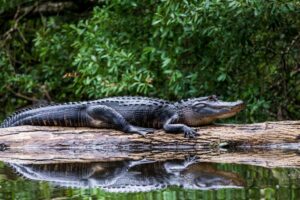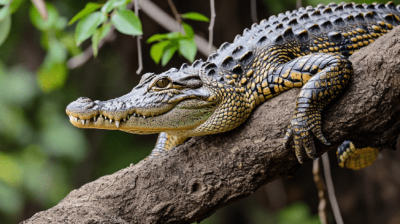So, have you ever found yourself pondering the wild and wacky world of nature, wondering if some creatures possess surprising skills beyond our imagination? Well, today’s curiosity revolves around the seemingly improbable question: Can alligators climb trees?
Yes, you heard it right – we’re diving into the realm of these fascinating reptiles to explore whether they possess the unexpected talent of scaling trees. So, buckle up for a journey into the intriguing world of alligators and the heights they may (or may not) reach!
Can alligators climb trees?

Yes, alligators can climb trees, although it’s not their most graceful skill. They’re surprisingly agile for their size and can leverage their strong legs and tails to clamber up branches. Just as said earlier, they are generally not known for their climbing abilities.
They are well-adapted to life in water and are excellent swimmers, but their anatomy is not designed for climbing trees. Alligators have short legs with webbed feet, a body adapted for aquatic movement, and a heavy tail, which makes them more suited for swimming and crawling on land than for climbing.
While they may be capable of some limited climbing in specific circumstances, such as using low branches to access a basking spot, it is not a common behavior for them. Unlike some other reptiles, such as certain species of snakes, alligators are not built for arboreal (tree-dwelling) activities.
Also, their natural habitat consists of freshwater environments like swamps, lakes, and rivers, where they are more likely to be found swimming or sunning themselves on the banks rather than climbing trees.
How high can alligators climb in trees?
Factors influencing alligator behavior and potential climbing abilities
The behavior of alligators is influenced by various factors, and their climbing abilities, while limited, may be influenced by certain environmental and situational factors.
Here are some factors that can influence alligator behavior and their potential for climbing:
- Environmental conditions: Alligators are adapted to thrive in aquatic environments such as swamps, lakes, and rivers. Their natural behaviors are strongly influenced by water conditions, temperature, and the availability of basking spots.
- Territorial behavior: Alligators are territorial animals, and their behavior can be influenced by the presence of other alligators or potential threats. Climbing trees might be a response to perceived danger or competition for territory.
- Basking and thermoregulation: Alligators often bask in the sun to regulate their body temperature. In some cases, they may use low branches or vegetation near the water to access basking spots, but this should not be confused with actual tree climbing.
- Age and size: Young alligators may be more agile than adults and might explore their surroundings more actively. Size and physical condition also play a role in their ability to navigate different terrains.
- Habitat variation: Alligators inhabit a range of environments, from freshwater swamps to coastal areas. The specific features of their habitat, such as the presence of trees or vegetation, could influence their behavior.
- Human influence: Human activities and modifications to the environment can impact alligator behavior. For example, alterations to natural habitats or the presence of structures near the water might create opportunities or challenges for alligators, potentially leading to unique behaviors.
It’s important to note that while alligators may exhibit some climbing behavior in specific situations, they are not specialized climbers like certain other reptiles. Their primary adaptations are for life in aquatic environments, and climbing is not a typical or common behavior for them.
Climbing behaviors observed in alligators

While climbing is not a typical behavior for alligators, there have been occasional reports of them displaying limited climbing abilities in certain situations. These observations are not common and are usually context-specific. Some instances where climbing behaviors have been reported include:
- Basking on low branches: Alligators are known to bask in the sun to regulate their body temperature. In some cases, they may use low-hanging branches or vegetation near the water to access sunny spots for basking. However, this is not the same as climbing trees in the way that some arboreal species might.
- Escape from predators: Alligators may exhibit climbing-like behavior when trying to escape from predators or perceived threats. In such situations, they might use whatever obstacles are available, including tree roots or sloping terrain, to move away from danger.
- Accessing nesting sites: Female alligators, during the nesting season, may construct nests in elevated areas to protect their eggs from flooding. While this involves ascending onto elevated ground, it doesn’t necessarily constitute climbing trees in the way that a specialized arboreal species would.
It’s important to emphasize that these behaviors are not the norm for alligators, and they are not evolved for true climbing like certain arboreal animals.
Alos, their anatomy and body structure are adapted for a semi-aquatic lifestyle, and climbing trees is not a common or natural behavior for them. Any observed climbing behavior is typically situational and may be prompted by specific environmental conditions or perceived threats.
Environmental factors affecting climbing capabilities
The climbing capabilities of animals, including alligators, can be influenced by various environmental factors. While alligators are not specialized climbers, certain conditions might encourage or facilitate climbing behaviors in some situations.
Here are some environmental factors that could affect climbing capabilities:
- Vegetation density: The presence of dense vegetation, such as low-hanging branches or tangled undergrowth, might provide opportunities for alligators to access elevated positions. Vegetation can act as a substrate or support for climbing, even if it is not a typical behavior.
- Proximity to water: Alligators are well-adapted to aquatic environments. The proximity of trees or other climbing structures to water may influence whether an alligator attempts to climb. They may use trees or elevated areas as basking spots near the water.
- Terrain gradient: The slope and structure of the terrain can impact an alligator’s ability to move vertically. If there are gradual slopes, embankments, or structures that allow for easy ascent, an alligator might be more likely to climb.
- Availability of basking sites: Alligators often bask in the sun to regulate their body temperature. If the preferred basking sites are located on elevated surfaces, alligators might navigate those structures for thermoregulation purposes.
- Human modifications: Human-made structures or alterations to the environment, such as levees, fences, or retaining walls, could create opportunities for climbing or impede natural movement. Alligators might interact with such structures in unexpected ways.
- Presence of predators or threats: The presence of predators or perceived threats can prompt alligators to seek refuge in elevated areas, possibly leading to climbing-like behaviors. This can be a response to escape from danger rather than a natural inclination to climb.

